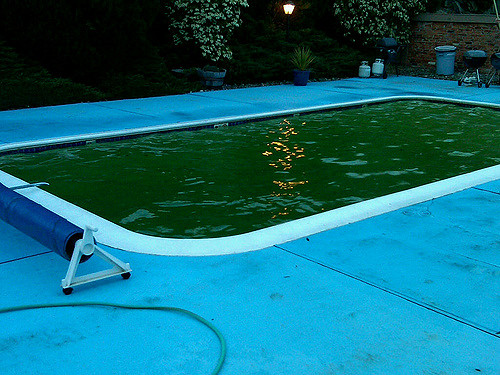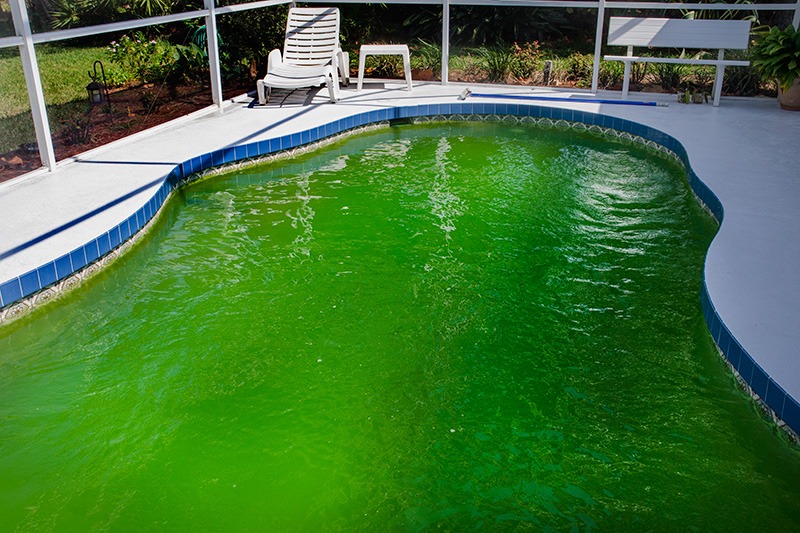Picture this.
Swim season is about to begin and you’re planning a huge family get-together in a week. You walk to your backyard, uncover the pool and find what looks to more closely resemble a swamp than any swimmable body of water. This isn’t the first time you’ve dealt with algae build up in your pool, but it somehow always seems to find a way back. But fear not, for when there’s a will there’s a way.
Of course, this is one enemy you’ll have to get to know a little bit better if you wish to conquer it for good.
Getting To Know Pool Algae | What Causes Algae In Pool
There are certain conditions that pool algae tend to thrive in.
Pool water that sits unsanitized (or chemically unbalanced) for an extended period of time provides the perfect nest for algae to develop in. Add warm temperatures and a lack of sunlight to the equation, and you’ll have an entire colony of algae establishing residence in no time. Luckily this process can easily be dealt with when caught in its early stages.
A teal to light green water coloration means there’s still time to nip the problem in the bud with an algaecide treatment. However, if the water is already dark green, the process of removal will be a bit more of a challenge – but first, here are a few quick preemptive tips to avoid pool algae altogether.
Tips To Prevent Pool Algae
- Maintain a clean swimming pool
- Brush the walls of the pool and vacuum at least once a week
- Maintain proper chemical levels (pH, Alkalinity, and Calcium Hardness)
- Apply a regular dosage of algaecide at least twice per month
- Run the filter and pump for at least 12 hours a day
- Regularly skim pool surface to avoid debris buildup
- Maintain Free Chlorine level at 3 ppm
Defeating A Pool Algae Colony | Algae Pool Treatment



In order to eliminate a persistent case of algae buildup, you’ll need a few tools.
- A 5-gallon bucket of water
- Calcium hypochlorite pool shock (pool algae killer)
- Wooden paint stirrer
- Latex gloves
- Protective eyewear
Pool Algae Identification
The first step is to determine how severe the pool algae buildup is. The color of the algae will determine how much shock is needed. Here’s a list of the most common pool algae types and their appropriate treatments.
- Teal: 2 pounds of shock per 10,000 gallons
- Green to Semi-Dark Green: 3 pounds of shock per 10,000 gallons
- Dark Green to Black: 4 pounds of shock per 10,000 gallons
Once you determined how much shock you’ll need, it’s time to begin the battle.
(TIP: For best results, carry out the procedure at night when the algae are weakest.)
- Turn on your pump and filter system (make sure the timer is off, as this process will require 24-hour filtering)
- Grab 5 gallon bucket and fill it with a combination of warm water and 1 pound of shock
IMPORTANT: Fill the bucket with water first, then slowly mix in shock - Use the paint stirrer to blend the mixture
- Once mixed, take the bucket and evenly distribute the mixture into the pool, covering as much area as possible
- Repeat Steps 1-4 in accordance with required amount of shock
After about 24 hours, check the color of your pool water. If it has resolved to a cloudy blue color, then you’ve successfully conquered the algae, congratulations!
Be sure to leave the pool pump and filter running until full water clarity is attained.
We hope you found this article helpful! Getting rid of algae is really as simple as analyzing the severity of the buildup, and applying the correct treatment as quickly as possible. But if you still have a few more questions on pool maintenance and pool ownership in general, check out our Pool Owner Guide. It covers everything from chemicals and water clarity, to pool heaters and filter systems.


